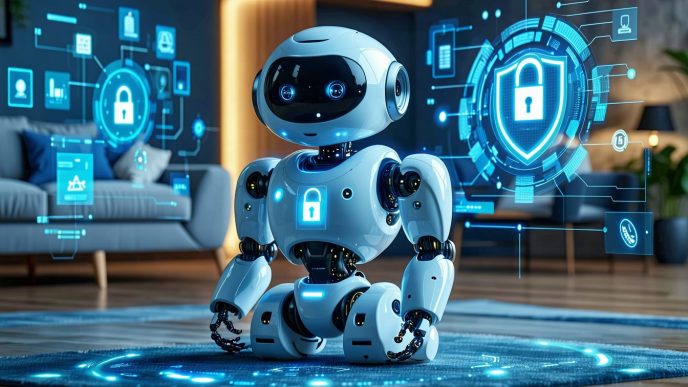The Role of Robots in Modern Homes
The introduction of robots into households has notably transformed the way families manage daily tasks. These advanced machines are being integrated into various aspects of home life, providing convenience and efficiency. However, this growing reliance on technology brings with it a host of concerns, especially regarding data privacy and security.
Increasing Presence of Robots in Homes
More households than ever are adopting robotic technology, ranging from vacuum cleaners to home assistants. Many homeowners appreciate the advantages robots bring, such as time savings and enhanced productivity. A recent survey indicated a significant increase in robot usage over the last few years.
| Year | Percentage of Households Using Robots |
|---|---|
| 2020 | 15% |
| 2021 | 25% |
| 2022 | 38% |
| 2023 | 50% |
This growing presence reflects a societal trend that embraces technology, yet it raises important questions about the management of data collected by these robots.
Concerns About Data Privacy and Security
As robots become fixtures in homes, concerns surrounding data privacy and security have emerged. Most robots are equipped with cameras and microphones, leading homeowners to worry about unauthorized surveillance and data breaches. These devices generate large amounts of data regarding user behavior and preferences, which can be sensitive.
The risks related to robot data privacy include:
- Unauthorized Data Access: Hackers may exploit vulnerabilities, gaining access to personal information.
- Data Sharing Without Consent: Some robots may share data with third parties or companies, often without the user’s explicit consent. Additional information can be found in our discussion on robot data sharing with companies.
- Invasive Surveillance: Concerns about constant monitoring by microphones and cameras can be unsettling for homeowners. This topic is further explored in our article on robot microphone and camera security.
To safeguard against these risks, homeowners should examine privacy settings, access controls, and permissions of their robotic devices. For more tips, visit our section on tips for keeping your robot secure. Understanding how these machines collect and store data, detailed in how robots collect and store data, is essential in making mindful decisions regarding their use.
As technology continues to evolve, staying informed about regulations surrounding robot data privacy, like those outlined in our article on regulations around robot data privacy, will empower owners to make educated choices about utilizing robots in their homes.
Understanding Data Storage in Robots
Data storage is a critical aspect of how robots operate and manage the information they collect. Homeowners need to consider the implications of both cloud storage and local storage when integrating these devices into their households.
Cloud Storage: Pros and Cons
Cloud storage allows robots to upload data to remote servers for processing and storage. This method has its advantages and disadvantages.
| Pros | Cons |
|---|---|
| Accessibility: Users can access data from any device with internet connectivity. | Privacy Risks: Data stored off-site can be vulnerable to unauthorized access or breaches. |
| Automatic Updates: Cloud services often include regular updates, enhancing functionality and security. | Dependence on Internet: Cloud storage requires a stable internet connection; disruptions may limit access. |
| Scalability: Users can easily increase storage capacity as needed without physical upgrades. | Potential Downtime: Cloud services may experience outages, affecting access to data. |
For more insights into how robots handle and store data, refer to our article on how robots collect and store data.
Local Storage: Pros and Cons
Local storage, on the other hand, keeps data directly on the robot itself or within a local network. This method has its own set of benefits and drawbacks.
| Pros | Cons |
|---|---|
| Control: Users maintain direct control over their data, reducing the risk of outside breaches. | Limited Accessibility: Data may only be accessible when physically present or connected to the device. |
| Reduced Dependence on Internet: Local storage allows robots to function without internet connectivity. | Storage Limitations: Physical storage capacity may be limited, necessitating periodic data management. |
| Faster Data Processing: Local processing can lead to quicker response times and less lag. | Difficulties in Updating: Users need to manage software updates manually, which can lead to security vulnerabilities. |
Understanding the implications of robot data privacy and safety concerns is essential when deciding between these storage methods. Homeowners should assess their individual needs and the potential risks associated with each option.
Importance of Data Security
As robots become increasingly integrated into daily life, understanding the importance of data security is critical for homeowners. With features like cameras and microphones, these devices can collect significant amounts of personal information. This section outlines the potential risks associated with data breaches and provides tips on protecting personal privacy.
Potential Risks of Data Breaches
Data breaches in robotic technology can have severe implications for user privacy. When sensitive information is compromised, it can lead to unauthorized access to one’s home, identity theft, or even surveillance. The following table highlights key risks associated with data breaches in robots:
| Risk Type | Description |
|---|---|
| Unauthorized Access | Hackers may gain control of a robot, allowing them to access the home network. |
| Identity Theft | Personal data can be used to impersonate homeowners or engage in fraudulent activities. |
| Privacy Invasion | Continuous data collection can lead to privacy violations, especially with cameras and microphones. |
| Data Misuse | Data may be shared with third-party companies without user consent, leading to further privacy concerns. |
Homeowners must be aware of how their robot collects and stores data, as outlined in our article on how robots collect and store data.
Protecting Your Privacy and Data
To safeguard privacy and data when using robots, several measures can be taken. Users should consider implementing the following strategies:
-
Review Privacy Settings: Adjust privacy settings to limit data collection and sharing. Many robots offer customizable options that allow users to manage what information is shared and collected. Explore more about privacy settings in home robots.
-
Use Strong Passwords: Create unique and complex passwords for robotic devices to prevent unauthorized access. It is also advisable to change default passwords upon setup.
-
Control Permissions: Regularly review robot access controls and permissions to ensure that only necessary data is shared with third parties. For more insights on this topic, refer to our article on robot access controls and permissions.
-
Stay Informed: Keep up with relevant regulations around robot data privacy. Understanding these can help users navigate their rights and responsibilities. Learn more about regulations around robot data privacy.
-
Regular Updates: Ensure that the robot’s software is continuously updated to defend against cybersecurity risks. For more details on risks associated with connected robots, see our article on cybersecurity risks of connected robots.
By actively taking these steps, homeowners can enhance their data security and reduce susceptibility to breaches associated with robotic devices. For further tips on maintaining security, visit our article on tips for keeping your robot secure.
Making Informed Choices
When integrating robots into a home, it is essential for homeowners, parents, tech adopters, and privacy-conscious consumers to consider several factors related to data privacy and security. This section highlights crucial questions to ask before purchasing a robot, as well as important factors to consider when evaluating data storage options.
Questions to Ask Before Purchasing a Robot
Before acquiring a robot, it is vital to ask specific questions to ensure that both privacy and security are addressed. Here are some key inquiries:
| Question | Purpose |
|---|---|
| What type of data does the robot collect? | Understanding the nature of data that will be gathered. |
| Where is the data stored—locally or in the cloud? | Clarifying whether the data is on-site or stored remotely informs security evaluations. |
| How is the data protected? | Gaining insight into security measures in place to safeguard information. |
| What are the robot’s privacy settings? | Ensuring customizable options are available for data management. |
| How does the robot share data with third parties? | Knowing if and how data may be shared helps in understanding potential risks. |
| Are there any regulations that the manufacturer adheres to? | Determining compliance with laws related to robot data privacy and safety concerns provides assurance of legal protection. |
Factors to Consider When Choosing Data Storage Options
Choosing between cloud storage and local storage is a critical decision that affects data security and privacy. Below are factors to consider regarding both options:
| Storage Type | Advantages | Disadvantages |
|---|---|---|
| Cloud Storage | – Accessible from anywhere with internet. – Easier updates and maintenance. – Integrated backup options. |
– Potential for data breaches. – Dependence on internet connection. – Less control over data storage. |
| Local Storage | – Greater control over data. – Reduced risk of online breaches. – Not reliant on internet connectivity. |
– Limited access if away from home. – Manual backups required. – May require regular maintenance of storage devices. |
When weighing options, homeowners should consider their specific needs, such as convenience against security risks. Reviewing detailed information on how robots collect and store data can guide decisions. Evaluating the robot’s access controls and permissions is also critical to ensure users have adequate control over their data.
Understanding these considerations equips individuals with the necessary knowledge to navigate potential risks associated with robotic technology, ensuring a safer integration of these devices into their homes.
Safeguarding Your Data
Ensuring data security is crucial for anyone integrating robots into their homes. As technologies evolve, so do the methods used to protect personal information. Implementing the right security measures and regularly updating settings can make a significant difference in safeguarding against unauthorized access.
Implementing Security Measures
Establishing strong security practices can enhance the safety of data collected by home robots. Homeowners should consider the following measures:
- Change Default Passwords: Many robots come with default passwords. Changing these to unique, complex passwords can prevent unauthorized access.
- Enable Two-Factor Authentication: Where possible, enabling two-factor authentication (2FA) adds an extra layer of security, requiring verification through a secondary device.
- Limit Data Sharing: Review the data sharing settings for the robot. Consider minimizing the amount of information sent to external companies. For more details on data sharing practices, visit our article on robot data sharing with companies.
- Regular Security Audits: Performing routine checks for software updates and security vulnerabilities can help in identifying potential risks early.
Regularly Updating and Monitoring Your Robot’s Settings
Ongoing vigilance is essential for maintaining data security. Homeowners are encouraged to:
- Check for Software Updates: Regular updates often include important security patches. Ensure that the robot’s software and applications are up to date.
- Monitor Privacy Settings: Regularly review privacy settings to ensure they align with personal preferences. This involves assessing what information is collected and how it is used. For insights, read our article on privacy settings in home robots.
- Review Access Controls: Understanding who has access to the robot’s data is crucial. Setting appropriate permissions can limit exposure to sensitive information. Learn more about this in our article on robot access controls and permissions.
By implementing robust security measures and diligently monitoring settings, homeowners can significantly mitigate risks associated with data privacy and security. For a deeper understanding of how robots handle data storage, review our article on how robots collect and store data. Here’s a summary of key practices in table format:
| Security Measure | Description |
|---|---|
| Change Default Passwords | Use strong, unique passwords for device access. |
| Enable Two-Factor Authentication | Add an extra verification step for security. |
| Limit Data Sharing | Keep data sharing to a minimum to protect privacy. |
| Regular Security Audits | Conduct routine checks for updates and vulnerabilities. |
| Check for Software Updates | Keep device software current to safeguard against threats. |
| Monitor Privacy Settings | Regularly assess and update what information is shared. |
| Review Access Controls | Define who can access sensitive data and settings. |
Prioritizing data security is essential as robots become more integrated into home life. With these proactive measures, owners can enjoy the benefits of technology while feeling secure in their data privacy. For more about the potential cybersecurity risks of connected robots, see our article on cybersecurity risks of connected robots.















